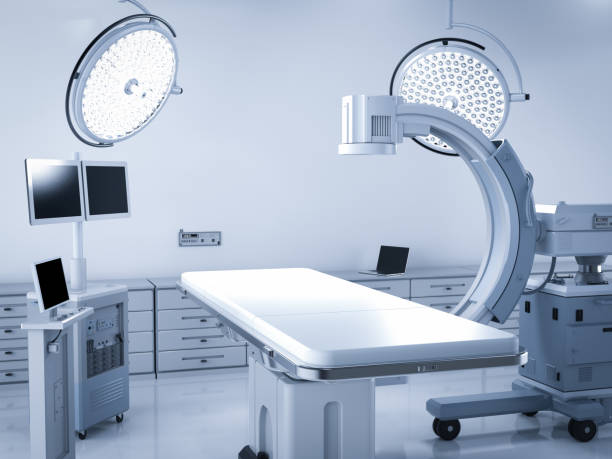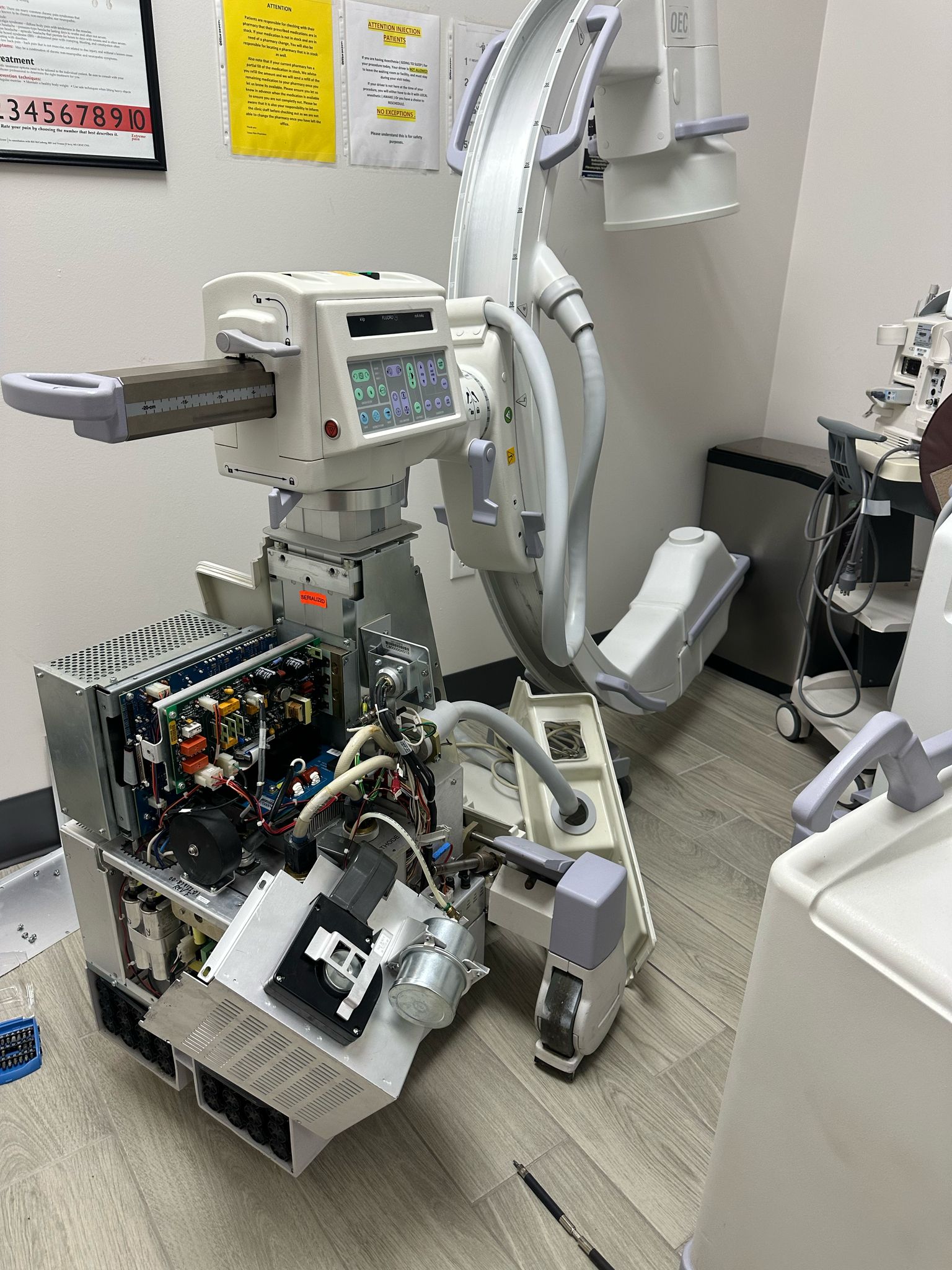
In an era of medical imaging, the term C-arm is the one that frequently comes up, especially in contexts involving complex surgical procedures and diagnostic processes. But what is a C-arm, and why is it so crucial in modern medicine?
This blog aims to provide a comprehensive understanding of C-arms, their uses, costs, and safety considerations, ensuring that healthcare professionals are well-informed about this vital piece of equipment.
C-Arm machines are sophisticated medical imaging devices that utilize X-ray technology. They derive their name from the C-shaped arm that connects the X-ray source to the detector. Renowned for their fluoroscopy capabilities, C-Arms also offer radiography functions, making them vital in modern medical settings.
C-Arms are highly versatile and are used in various medical fields such as orthopedics, urology, gastroenterology, complex surgical procedures, pain management, emergency care, cardiac studies, and therapeutic interventions including stent placements and needle insertions. The fluoroscopy technology provides real-time, high-resolution X-ray images, allowing surgeons to perform procedures with greater accuracy and better patient outcomes. Additionally, the mobility of C-Arm systems provides the flexibility to capture images from multiple angles, addressing a wide range of patient needs effectively.
Mobile C-Arm machines are complex devices that include several key components: an X-ray generator, an image intensifier or flat-panel detector, and a control-equipped workstation. The unique C-shaped arm of the device allows it to move in various directions horizontally, vertically, and around its swivel axis facilitating diverse imaging angles.
The process begins with the X-ray generator emitting X-rays that pass through the patient's body. These X-rays are then captured by the image intensifier or detector, which converts them into visible images displayed on the C-Arm's monitor. This setup allows medical professionals to view detailed anatomical structures such as bones, fractures, and the positioning of implants and instruments in real-time. This capability significantly enhances the precision and safety of various medical procedures.
What is a C-arm used for? C-arms are predominantly used in orthopaedic surgeries, cardiovascular procedures, and various types of diagnostic imaging. Their ability to provide real-time, high-resolution X-ray images helps surgeons and physicians visualize the internal structures of the body during procedures. This real-time imaging capability is crucial for guiding interventions and ensuring precision.
Call us today at +1 (469) 767-8853 and let's chat OR visit us at 555 N 5th St #109, Garland, TX 75040, United States.
What is a C-arm used for in various medical settings? The versatility of C-arms makes them indispensable in the following applications:
Orthopaedic Surgery: C-arms provide detailed images of bones, aiding surgeons in performing precise alignments and fixations.
Cardiovascular Procedures: They are used to visualise blood vessels and guide interventions such as angioplasty.
Gastrointestinal Studies: C-arms help in diagnosing and treating conditions within the gastrointestinal tract.
Emergency Medicine: In trauma cases, C-arms are used to quickly assess injuries and plan immediate interventions.
Safety is a paramount concern when using any form of X-ray equipment. How far away from a C-arm is safe is a question often raised by healthcare professionals to minimise radiation exposure. It is generally recommended that non-essential personnel maintain a distance of at least 6 feet from the C-arm during its operation. Additionally, wearing lead aprons and thyroid shields can further reduce exposure risks.
Radiography generates images through X-rays, which can be stored digitally or on X-ray film. Fixed fluoroscopy techniques, like barium meal studies, offer dynamic real-time images by using X-rays to observe body structures and fluid movements such as blood or contrast agents. Radiography and fixed fluoroscopy are predominantly used for diagnostic purposes. In contrast, C-Arms, while also utilizing fluoroscopy, are primarily utilized to aid surgical procedures. Their capacity to deliver live imaging during surgeries is essential for various medical interventions.
In surgical settings, a common question is, do they strap your arms down during a C-section? During a cesarean section, the patients arms may be gently restrained to prevent any involuntary movements that could interfere with the procedure. However, this is a standard practice for patient safety and is not directly related to the use of C-arms.
Over the years, C-arm technology has advanced significantly, offering improved image quality, reduced radiation doses, and enhanced user interfaces. These advancements have expanded the range of procedures that can be performed with the aid of C-arms, making them an even more invaluable tool in modern medicine.
They provide functionalities such as 3D imaging and flat-panel detectors (FDP). 3D imaging merges 2D X-ray projections to generate CT-like images, which are beneficial for therapy planning, guidance, and outcome evaluation. FDPs offer reduced patient radiation exposure, superior image quality, and long-term stability, making them increasingly favoured in contemporary C-Arm systems.
The primary benefits of using C-arms include:
Enhanced Visualization: Provides clear, real-time images that help in accurate diagnosis and treatment.
Increased Precision: Aids in precise surgical interventions, reducing the risk of errors.
Versatility: Can be used in a wide range of medical procedures across different specialities.
Improved Patient Outcomes: Facilitates better planning and execution of medical interventions, leading to improved patient outcomes.
For healthcare facilities considering the acquisition of a C-arm, several practical considerations come into play. These include evaluating the specific needs of the facility, the types of procedures performed, and the budget available for equipment. Facilities must also consider the training and certification of staff to ensure the safe and effective use of C-arms.
When deciding on acquiring a C-arm, the choice between purchasing and renting can depend on various factors. How much a C-arm costs can be a significant consideration for many facilities? While purchasing may be suitable for high-volume centres, renting can offer flexibility and cost savings for facilities with occasional or varied use.
Mr. Biomed Tech Services offers very economical prices for C-arm machines, available for both rental and purchase. We are known for our trust and quality, providing reliable medical equipment for years.
C-arms are an essential component of modern medical imaging, offering unparalleled versatility and precision in various medical procedures. Understanding what a C-arm is, how C-arm machines work, and what a C-arm is used for can help healthcare professionals maximize the benefits of this technology while ensuring patient safety.
For those needing reliable and cost-effective access to C-arms, whether for purchase or rental, Mr Biomed Tech Services is a trusted provider offering a range of options to meet your needs. Contact Mr. Biomed Tech Services for more information and to explore the best solutions for your medical imaging requirements.
Need help? Please call us at +1 (469) 767-8853. We are just a click-and-call away!
A C-arm is a medical imaging device based on X-ray technology. It gets its name from its C-shaped arm that connects the X-ray source to the X-ray detector, allowing for versatile positioning around the patient to capture real-time images.
C-arms are primarily used in orthopaedic surgeries, cardiovascular procedures, gastrointestinal studies, and emergency medicine. They provide high-resolution, real-time images that help guide surgeons and physicians during procedures.
The cost of a C-arm depends on the brand, model, and features. Refurbished units are also available at lower prices, making them an affordable option for many healthcare facilities.
A C-arm machine works by emitting X-rays from a source located on one end of the C-shaped arm. These X-rays pass through the patient's body and are captured by a detector on the opposite end. The captured images are displayed on a monitor in real time.
To minimize radiation exposure, non-essential personnel should maintain a distance of at least 6 feet from the C-arm during operation. Additionally, wearing protective gear such as lead aprons and thyroid shields can further reduce exposure risks.
During a cesarean section, a patient's arms may be gently restrained to prevent any involuntary movements that could interfere with the procedure. This practice is for patient safety and is not directly related to the use of C-arms.